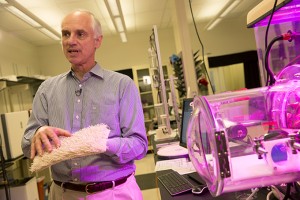August 3, 2015
 For many of us, it can be easy to let the relationship we share with our environment go unnoticed. Let’s get back to basics. Every time you take a breath, you take in oxygen and give out carbon dioxide (CO2).
For many of us, it can be easy to let the relationship we share with our environment go unnoticed. Let’s get back to basics. Every time you take a breath, you take in oxygen and give out carbon dioxide (CO2).
While we emit CO2, trees and plants drink it up while simultaneously releasing oxygen for us. They need carbon dioxide to survive, just like we need oxygen. This symbiotic relationship is crucial to life on our planet.
But as fossil fuel consumption by a growing world population rapidly increases, we’re putting out more CO2 than our trees and plants can absorb. And because CO2 is a greenhouse gas, there are concerns that all this carbon dioxide is heating up our planet and contributing to climate change.
For some researchers at ASU, the solution is obvious. They believe that carbon capture technologies will aid in what trees and plants have been doing for centuries—help reduce the amount of CO2 in our atmosphere.
Cost-effective capture
Dan Buttry, professor and chair of ASU’s Department of Chemistry and Biochemistry, is leading a project that can help power plants to reduce the amount of carbon emitted during production. The device his team developed, which is similar to a fuel cell, uses an electrochemical process to separate CO2 from other power plant emissions. This electrochemical reaction effectively pushes CO2 through a filter in order to contain it, and is significantly more energy efficient and cost-effective than other carbon capture technologies. The captured CO2 not only aids in reducing greenhouse gas levels, but it could potentially be used to produce sustainable transportation fuels.
In 2012, Buttry’s team was awarded an ARPA-E grant from the U.S. Department of Energy to develop their efficient and cost-effective carbon capture technology. The ARPA-E program supports high-risk, high-reward research that can provide transformative new solutions for climate change and energy security. So far, the team has successfully identified a new membrane, increased the efficiency of the device, and modified the electrolyte for chemical stability.
Through this system, ASU plans on reducing the cost of capturing CO2 by more than half compared to existing processes, while establishing a new manufacturing industry for large-scale applications. This technology uses less energy than commercial carbon capture systems and easily retrofits at existing facilities.
Carbon negative—beyond carbon neutral
Klaus Lackner, a professor in the Center for Negative Carbon Emissions (CNCE). Instead of capturing carbon from industrial smokestacks, engineers at the center are looking to capture it from thin air.
Shaped like evergreen tree branches, Lackner’s air capture technology “scrubs” carbon dioxide from the air we breathe. This ambient air, or still air technology, makes Lackner’s carbon capturing trees different from traditional carbon reduction approaches.
The Center for Negative Carbon Emissions doesn’t only plan to capture carbon dioxide for disposal. They are also looking at ways to recycle the CO2 for production of synthetic fuels, as well as provide a food source for plants in greenhouses. The center is teaming up with other like-minded initiatives at the university, such as LightWorks and the College of Liberal Arts and Sciences. The School of Sustainable Engineering and the Built Environment is a unit of the Ira A. Fulton Schools of Engineering.
Learn more about ASU research and expertise on carbon and climate.
Written by Gabrielle Olson, ASU LightWorks
Photo by Jessica Hochreiter
- See more at: https://researchmatters.asu.edu/stories/carbon-capture-3960#sthash.WtWFGKk6.dpuf

